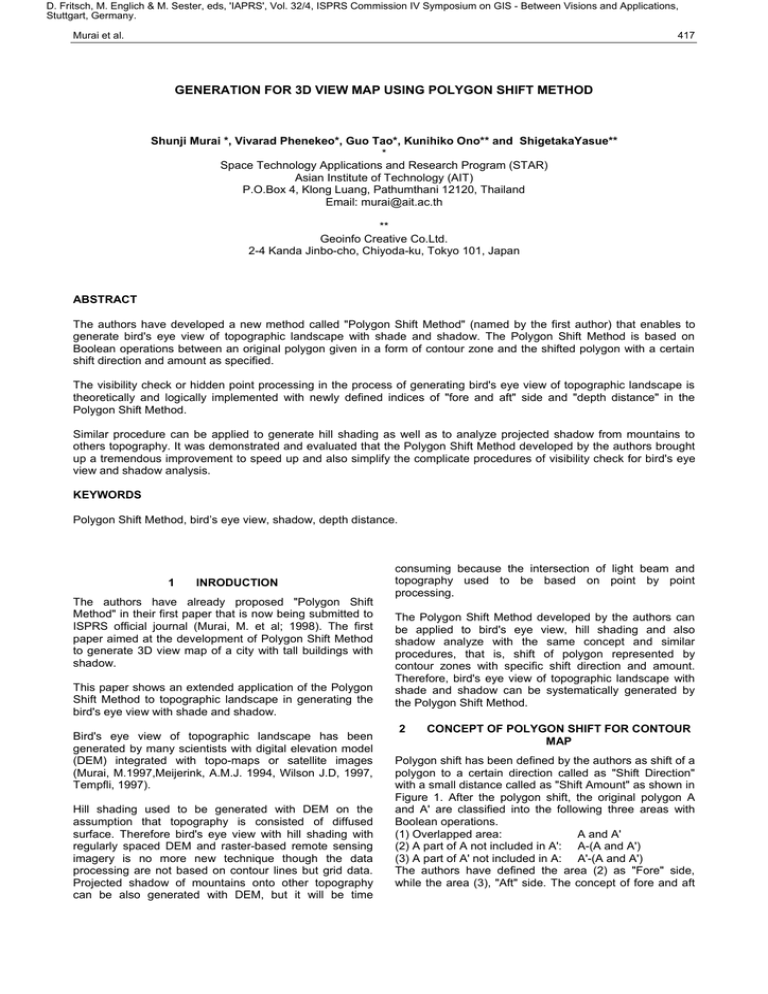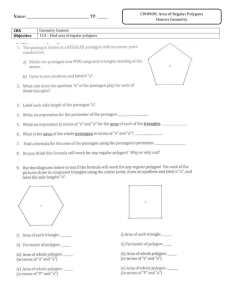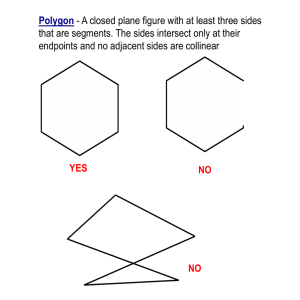Document 11841611
advertisement

D. Fritsch, M. Englich & M. Sester, eds, 'IAPRS', Vol. 32/4, ISPRS Commission IV Symposium on GIS - Between Visions and Applications, Stuttgart, Germany. Murai et al. 417 GENERATION FOR 3D VIEW MAP USING POLYGON SHIFT METHOD Shunji Murai *, Vivarad Phenekeo*, Guo Tao*, Kunihiko Ono** and ShigetakaYasue** * Space Technology Applications and Research Program (STAR) Asian Institute of Technology (AIT) P.O.Box 4, Klong Luang, Pathumthani 12120, Thailand Email: murai@ait.ac.th ** Geoinfo Creative Co.Ltd. 2-4 Kanda Jinbo-cho, Chiyoda-ku, Tokyo 101, Japan ABSTRACT The authors have developed a new method called "Polygon Shift Method" (named by the first author) that enables to generate bird's eye view of topographic landscape with shade and shadow. The Polygon Shift Method is based on Boolean operations between an original polygon given in a form of contour zone and the shifted polygon with a certain shift direction and amount as specified. The visibility check or hidden point processing in the process of generating bird's eye view of topographic landscape is theoretically and logically implemented with newly defined indices of "fore and aft" side and "depth distance" in the Polygon Shift Method. Similar procedure can be applied to generate hill shading as well as to analyze projected shadow from mountains to others topography. It was demonstrated and evaluated that the Polygon Shift Method developed by the authors brought up a tremendous improvement to speed up and also simplify the complicate procedures of visibility check for bird's eye view and shadow analysis. KEYWORDS Polygon Shift Method, bird’s eye view, shadow, depth distance. 1 INRODUCTION The authors have already proposed "Polygon Shift Method" in their first paper that is now being submitted to ISPRS official journal (Murai, M. et al; 1998). The first paper aimed at the development of Polygon Shift Method to generate 3D view map of a city with tall buildings with shadow. This paper shows an extended application of the Polygon Shift Method to topographic landscape in generating the bird's eye view with shade and shadow. Bird's eye view of topographic landscape has been generated by many scientists with digital elevation model (DEM) integrated with topo-maps or satellite images (Murai, M.1997,Meijerink, A.M.J. 1994, Wilson J.D, 1997, Tempfli, 1997). Hill shading used to be generated with DEM on the assumption that topography is consisted of diffused surface. Therefore bird's eye view with hill shading with regularly spaced DEM and raster-based remote sensing imagery is no more new technique though the data processing are not based on contour lines but grid data. Projected shadow of mountains onto other topography can be also generated with DEM, but it will be time consuming because the intersection of light beam and topography used to be based on point by point processing. The Polygon Shift Method developed by the authors can be applied to bird's eye view, hill shading and also shadow analyze with the same concept and similar procedures, that is, shift of polygon represented by contour zones with specific shift direction and amount. Therefore, bird's eye view of topographic landscape with shade and shadow can be systematically generated by the Polygon Shift Method. 2 CONCEPT OF POLYGON SHIFT FOR CONTOUR MAP Polygon shift has been defined by the authors as shift of a polygon to a certain direction called as "Shift Direction" with a small distance called as "Shift Amount" as shown in Figure 1. After the polygon shift, the original polygon A and A' are classified into the following three areas with Boolean operations. (1) Overlapped area: A and A' (2) A part of A not included in A': A-(A and A') (3) A part of A' not included in A: A'-(A and A') The authors have defined the area (2) as "Fore" side, while the area (3), "Aft" side. The concept of fore and aft D. Fritsch, M. Englich & M. Sester, eds, 'IAPRS', Vol. 32/4, ISPRS Commission IV Symposium on GIS - Between Visions and Applications, Stuttgart, Germany. 418 IAPRS, Vol. 32, Part 4 "GIS-Between Visions and Applications", Stuttgart, 1998 side will effectively work for hill shading as well as visibility check. the shift amount proportional to shadow length or sun elevation. The procedure of polygon shift can be repeated sequentially depending on the elevation of contour zone as shown in Figure 2. Figure 3 shows the repetition of three times each for three different contour zones for generation of bird's eye view, in which "aft" sides are erased as invisible areas. The visibility check with the depth distance can be also used to judge whether a point in an overlapped polygon between different contour zones that were shifted with the specific polygon shift. If the depth distance of a point A is longer than another point B at the same location in the shifted polygon, A gives shadow to B, or B is shadowed by A. 3 VISIBILITY CHECK WITH DEPTH DISTANCE The authors have developed a concept of "Depth Distance" (named by the authors) that gives as indicator to judge logically whether a point on a polygon hides other points or is hidden by other points, in link with the polygon shift. Depth distance is given to each contour zone or polygon depending to unit of shift amount multiplied by the repetition that will be proportional to the elevation of the contour. Supposed that two contour zones with relative value of elevation are given as shown in Figure 4, the polygon shift will be implemented with the shift amount multiplied by the repetition that makes two contour zones overlap each other as shown in Figure 5. The depth distance of higher contour zone is also bigger. In the overlapped area, bigger depth distance will replace the smaller depth distance. The replacement will give a rule that the replaced point is hidden by the replacing point. The above mentioned principle can be applied to any complicate contour zones, that is firstly polygon shift and secondly replacement of pixels in overlapped area by the bigger value of depth distance. 4 In this study, the authors named "View Shift" for 3D view map of topographic landscape and "Shadow Shift" for shadow analysis as shown in Figure 7. Figure 7 shows the geometric relation between view and shadow shift. In this figure, point P, for example, is located in the overlapped area of the highest contour zone of Mt.No.1 and the second highest contour zone of Mt.No.2 in the shadow shift space. The depth distance of the former point is PA', while the one of the latter point PB' that is shorter than the former's. It means point A gives shadow to point B. Therefore point B in the view shadow be assigned as shadowed point. Figure 8 shows a sample of 3D view map with shadow. 6 1. A Polygon Shift Method was proposed and applied to bird’s eye view with shade and shadow without any complicate calculation such as intersection of a beam and given terrain surface. 2. It was found that the Polygon Shift Method could be widely applied to visibility check for hidden and/or shadowed point with newly defined depth distance. 3. The Polygon Shift Method enabled to define not only geometry but also topology in handling raster data in a form of contour zone. HILL SHADING FOR CONTOUR ZONES Hill shading is defined as diffused reflection from the surface of terrain with a given illumination. In order to assist human sense for understanding the topographic relief, illumination is usually selected its azimuth from north west and the elevation angle 45 degree. The conventional way of hill shading defines the shading amount or ratio as cosine of angle between illumination beam and normal vector of the terrain surface that can be derived from DEM, under the assumption that the terrain surface is consisted of diffused surface or Lambertian surface. Generally hill shading depends on the slope aspect and gradient according to the above mentioned rule. Slope faced to north west should be brighter because the shade is smaller, while slope faced to south east, darker. The Polygon Shift Method will make such simple rule easily if the direction of polygon shift is taken north west or left upper in the case of Figure 6. The "Aft" side corresponds to north west slope while "Fore" side, south east slope. Therefore hill shading in the Polygon method is assigned brighter color tone to "Aft", darker to "Fore". 5 SHADOW ANALYSIS The Polygon Shift Method can be applied to shadow analysis with the shift direction taken as shadow azimuth, CONCLUSIONS 7 REFERENCES 1. Meijerink, Allard M.J. et al ; Introduction to the use of Geographic Information System for Practical Hydrology, ITC Publication N0.23, Enschede, 1994 2. Murai, S., et al ; Development of Polygon Shift Method for Generating 3D View Map of Buildings; ISPRS official Journal “Photogrammetry and Remote Sensing” (in submission) 1998 3. Murai, S.; GIS Work Book – Technical Course, Japan Association of Surveyors, Jan. 1997 4. Tempfli, Klaus; Photogrammetry for urban 3-D GIS, GIM International, Vol. 11, No. 1, 1997 pp. 60-63 5. Wilson J.D. ; Shopping Around for Data ; GIS Asian Pacific, December 1997/January 1998, pp. 24-28 D. Fritsch, M. Englich & M. Sester, eds, 'IAPRS', Vol. 32/4, ISPRS Commission IV Symposium on GIS - Between Visions and Applications, Stuttgart, Germany. Murai et al. 419 Figure 1 Concept of Polygon Shift Figure 2 Repetition of Polygon Shift Figure 3 Polygon Shift of Contour Zones Figure 4 Relative Value of Elevation for two Contour Zones Figure 5 Depth Distance defined with Figure 6 Hill Shading by Fore and Aft Polygon Shift Concept D. Fritsch, M. Englich & M. Sester, eds, 'IAPRS', Vol. 32/4, ISPRS Commission IV Symposium on GIS - Between Visions and Applications, Stuttgart, Germany. 420 Figure 7 IAPRS, Vol. 32, Part 4 "GIS-Between Visions and Applications", Stuttgart, 1998 Geometric Relation between View and Shadow Shift (Point B is shadowed by Point A) D. Fritsch, M. Englich & M. Sester, eds, 'IAPRS', Vol. 32/4, ISPRS Commission IV Symposium on GIS - Between Visions and Applications, Stuttgart, Germany. Murai et al. Figure 8 421 Sample of 3D View Map with Shadow




